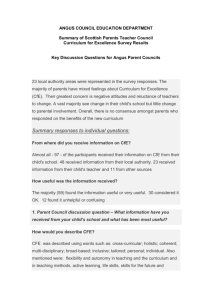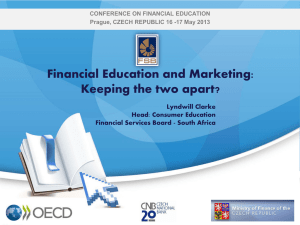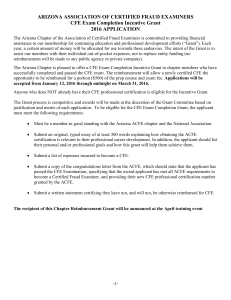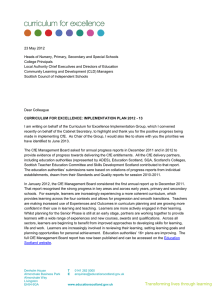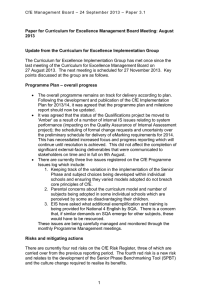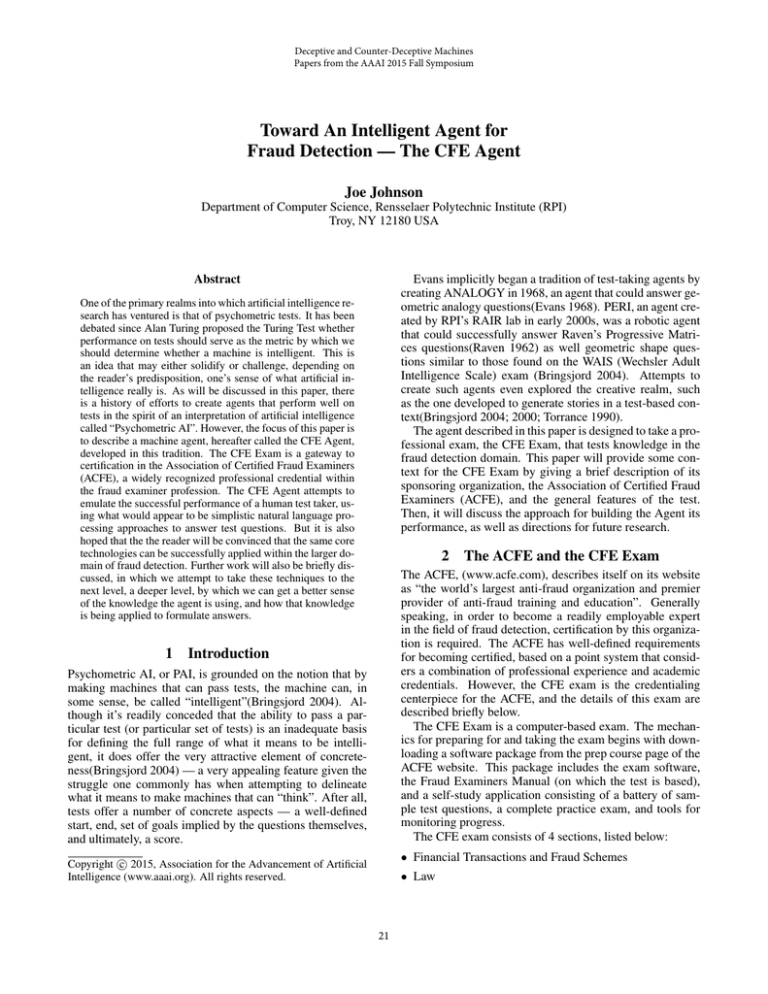
Deceptive and Counter-Deceptive Machines
Papers from the AAAI 2015 Fall Symposium
Toward An Intelligent Agent for
Fraud Detection — The CFE Agent
Joe Johnson
Department of Computer Science, Rensselaer Polytechnic Institute (RPI)
Troy, NY 12180 USA
Abstract
Evans implicitly began a tradition of test-taking agents by
creating ANALOGY in 1968, an agent that could answer geometric analogy questions(Evans 1968). PERI, an agent created by RPI’s RAIR lab in early 2000s, was a robotic agent
that could successfully answer Raven’s Progressive Matrices questions(Raven 1962) as well geometric shape questions similar to those found on the WAIS (Wechsler Adult
Intelligence Scale) exam (Bringsjord 2004). Attempts to
create such agents even explored the creative realm, such
as the one developed to generate stories in a test-based context(Bringsjord 2004; 2000; Torrance 1990).
The agent described in this paper is designed to take a professional exam, the CFE Exam, that tests knowledge in the
fraud detection domain. This paper will provide some context for the CFE Exam by giving a brief description of its
sponsoring organization, the Association of Certified Fraud
Examiners (ACFE), and the general features of the test.
Then, it will discuss the approach for building the Agent its
performance, as well as directions for future research.
One of the primary realms into which artificial intelligence research has ventured is that of psychometric tests. It has been
debated since Alan Turing proposed the Turing Test whether
performance on tests should serve as the metric by which we
should determine whether a machine is intelligent. This is
an idea that may either solidify or challenge, depending on
the reader’s predisposition, one’s sense of what artificial intelligence really is. As will be discussed in this paper, there
is a history of efforts to create agents that perform well on
tests in the spirit of an interpretation of artificial intelligence
called “Psychometric AI”. However, the focus of this paper is
to describe a machine agent, hereafter called the CFE Agent,
developed in this tradition. The CFE Exam is a gateway to
certification in the Association of Certified Fraud Examiners
(ACFE), a widely recognized professional credential within
the fraud examiner profession. The CFE Agent attempts to
emulate the successful performance of a human test taker, using what would appear to be simplistic natural language processing approaches to answer test questions. But it is also
hoped that the the reader will be convinced that the same core
technologies can be successfully applied within the larger domain of fraud detection. Further work will also be briefly discussed, in which we attempt to take these techniques to the
next level, a deeper level, by which we can get a better sense
of the knowledge the agent is using, and how that knowledge
is being applied to formulate answers.
1
2
The ACFE and the CFE Exam
The ACFE, (www.acfe.com), describes itself on its website
as “the world’s largest anti-fraud organization and premier
provider of anti-fraud training and education”. Generally
speaking, in order to become a readily employable expert
in the field of fraud detection, certification by this organization is required. The ACFE has well-defined requirements
for becoming certified, based on a point system that considers a combination of professional experience and academic
credentials. However, the CFE exam is the credentialing
centerpiece for the ACFE, and the details of this exam are
described briefly below.
The CFE Exam is a computer-based exam. The mechanics for preparing for and taking the exam begins with downloading a software package from the prep course page of the
ACFE website. This package includes the exam software,
the Fraud Examiners Manual (on which the test is based),
and a self-study application consisting of a battery of sample test questions, a complete practice exam, and tools for
monitoring progress.
The CFE exam consists of 4 sections, listed below:
Introduction
Psychometric AI, or PAI, is grounded on the notion that by
making machines that can pass tests, the machine can, in
some sense, be called “intelligent”(Bringsjord 2004). Although it’s readily conceded that the ability to pass a particular test (or particular set of tests) is an inadequate basis
for defining the full range of what it means to be intelligent, it does offer the very attractive element of concreteness(Bringsjord 2004) — a very appealing feature given the
struggle one commonly has when attempting to delineate
what it means to make machines that can “think”. After all,
tests offer a number of concrete aspects — a well-defined
start, end, set of goals implied by the questions themselves,
and ultimately, a score.
• Financial Transactions and Fraud Schemes
c 2015, Association for the Advancement of Artificial
Copyright Intelligence (www.aaai.org). All rights reserved.
• Law
21
• Investigation
• Fraud Prevention and Deterrence.
Each section consists of 125 multiple choice and truefalse questions. The candidate is limited to 75 seconds to
complete each question and a maximum total allocated time
of 2.6 hours to complete each section. Each CFE Exam section is taken separately. The timing for each section is subject to the candidates discretion. However, all four sections
of the exam must be completed and submitted to the ACFE
for grading within a 30 day period.
The goal was to develop a computer system that could
pass the CFE exam subject to the constraints outlined above.
This project involved procuring the study package and exam
resources, customizing their format for automated processing, and developing and testing the CFE Agent, an extensible system that utilizes various algorithms along with these
resources to answer test questions on a given exam.
3
Figure 1: Embedded Practice Question
Resource Procurement and Customization
The first phase of this project after downloading the study
package was to convert its contents to a form that could
be processed by an automated system. The content in the
package include a Fraud Examiners Manual in pdf format,
practice questions embedded within study package software,
and a practice exam, also consisting of questions embedded
within custom software. It was necessary to convert each
of these components into text-formatted documents for the
CFE Agent.
The first of these components, the Fraud Examiners Manual, is a 2,200 page pdf document that serves as the principal resource from which all of the exam questions are
drawn. Conversion of this document involved an extensive
amount of work for two reasons: First, the pdf document
itself was password protected, rendering most pdf conversion programs useless. And second, the few software packages that were capable of bypassing the password protection
produced intermittent errors in the generated text, inserting
spaces randomly between the letters of words. Given the
large volume of content, a program employing various parsing techniques was written to sequentially walk through the
text, detect errors, make corrections automatically based on
certain rules, or prompt for correction if an error was detected but manner of correction was uncertain. Although a
significant amount of effort was expended to develop this
technology, in the end much of the document was edited
manually.
The other main component of the prep package is the
database of 1,500 questions embedded in the study package
software. The extraction of these questions from the software was an involved, multi-step process. First, a screenshot
file, as shown in Figure 1, was created for each question.
Second, optical character recognition (OCR) software was
used to convert the graphic screen shot files into text files, as
shown in Figure 2. Unfortunately, the important data needed
for each question was intermingled among nonsensical overhead text in each of these text files. So, a custom program
was created to parse these text files, remove the unnecessary
data, and decompose each question into its component parts
Figure 2: Converted, Unscrubbed Practice Question
Figure 3: Scrubbed Practice Question
— topic, question stem, options, correct answer, and explanation — as shown in Figure 3. Finally, these files were
manually reviewed and edited to ensure proper format for
the Agent. The product of this process was a collection of
1,500 text files, one for each practice exam question, and
each containing name-value pairs for the relevant question
fields named above.
4
CFE Agent Design
The CFE Agent is written in Java. It takes as input a collection of question files and produces as output a sequence
of answers which are, in turn, compared against the corresponding correct answers in order to calculate a score. There
are four principal elements to the design of the CFE Agent
— the CFE manual, the question profile, the algorithm set,
22
Max Frequency Algorithm The Max Frequency Algorithm simply counts up the total number of times each answer option is encountered in the manual section from which
the question was drawn and selects the option whose tally is
the largest. Unlike the Max Joine Probability Algorithm, the
frequencies are based on occurrences of entire phrases, not
on the counts of individual words within them.
and the selection algorithm.
CFE manual
The Fraud Examiners Manual (known by the CFE Agent
as the CFE Manual) is the text corpus on which all of the
questions of the CFE Exam are based. It is also the corpus,
therefore, on which the CFE Agent executes algorithms to
answer exam questions. Fortunately, each question includes
a section heading that loosely maps to an individual section within the manual. However, these sections are roughgrained; i.e., relatively large (often 20–100 pages). So, although these headings provide some advantage to the agent,
there is still work to be done to shrink the text that is analyzed for each question. Efforts to narrow the scope of the
text using information retrieval techniques are currently under way, and are discussed the Future Work section. However, even these rough-grained sections provide significant
success in accurately answering questions.
False Select This algorithm applies only to true-false
questions, simply selecting false, always. Remarkably, this
algorithm proved extremely effective for such questions that
have “must”, “always”, “only”, or “never” in the stem,
achieving an astonishing 78.7% accuracy rate on this class
of questions. The remarkable success of such a simple algorithm is an indication of the effectiveness of gaming strategies on certain questions, but also an indication of weaknesses in the way certain questions on this exam are designed.
The Selection Algorithm
Question Profile
The selection algorithm is the procedure for selecting the
proper algorithm to apply to a given question. It is based
on the experience data collected from executing every algorithm on every question in the study package. For a given
question, the CFE Agent chooses the algorithm with the
highest accuracy rate for questions with the same profile.
After having reviewed the entire database of questions in
the study package, it was determined that there are certain
characteristics certain questions share in common. This was
thought to be a natural way of partitioning the questions according to a crude ontology each class of which could serve
as a means for optimizing an algorithm for the questions of
that class. For example, one of the most obvious of these
characteristics is whether the question is a true-false question or a multiple choice question. And if the question is
true-false, does it include any of the following terms: “always”, “never”, “must”, or “only”? On the other hand, if
a question is multiple choice, is its last option, “All of the
above”? Some other criteria discovered that are worth noting are whether the question includes options with more than
four words in it, whether the question contains the word “except”, and whether the question’s last option is “None of the
above”.
5
CFE Agent Demo
This section outlines a walkthrough of the execution of the
CFE Agent for a very short exam, consisting of only four
questions. Despite its short length, it should provide a good
idea of the basic mechanics of the agent.
Since the CFE Agent is written in java, starting the agent
requires invoking the java virtual machine on the main class
of the program, appropriately called, CFEAgent. Figure 4,
below, shows the startup of the agent. The name of a configuration file is passed in as a command line parameter to
the program. This file provides a number of settings for the
execution environment, including the mode (interactive vs.
batch), the name of the exam file, and log detail level. In
this demo, the agent is executing with full detail so that it is
easier to understand what is happening under the covers for
each question.
The detail logging shows that one of the first things the
CFE Agent does when it starts up is construct an internal
representation of the Fraud Examiners Manual. This internal
representation is in the form of a graph, each of whose nodes
represents a section of the document. More specifically, the
graph is a tree whose root node represents the entire manual,
which in turn possesses links to child nodes each representing one of the four main sections of the manual (Financial
Transactions and Fraud Schemes, Law, Investigation, and
Fraud Prevention and Deterrence) each of which in turn possesses child nodes representing sub-sections to those sections, and so on. Each node stores information about the
section it represents in addition to the text itself, including
a hash table for word counts, sub-subheadings, etc. This information facilitates the text analytic computations the agent
performs as it answers questions on the exam. It should
Algorithm Set
Various algorithms were developed an incorporated into the
model. Furthermore, the system is highly extensible so that
new ones yet to be developed can easily be incorporated.
The system currently employs nine custom algorithms that
utilize natural language processing, information retrieval,
and general test-taking techniques. Descriptions of a few
example algorithms are given below:
Max Joint Probability Algorithm This algorithm considers only the possible answers, treating each as a sequence of
words whose joint probability is to be calculated. It calculates this joint probability for each option by finding the
probability of each word among the words of the manual
section from which the question was drawn (indicated by
topic) and by applying the simplifying assumption of independence between words. The joint probability, then, is
simply calculated as the product of the probabilities of the
individual words of the option, normalized for the number
of words (so that short answers are not over-weighted). The
algorithm selects the option with maximum joint probability.
23
Figure 4: CFE Agent Startup
Figure 6: Question 1
Figure 5: CFE Agent Startup Completed
Figure 7: Question 1 Completed
be noted that much of the basis of this tree data structure
is based on the items listed in the manuals table of contents, and for even finer-grained detail nodes, on text features within the corpus itself. (That is, lines of text consisting of all capital letters terminating in carriage return generally denote a sub-section of text). Finally, in addition to the
tree data structure, the internal representation of the manual
includes additional data structures mapping the text of the
manual for optimizing access to particular manual subsections.
In Figure 5, the screen shows the completion of the startup
sequence of the CFE Agent. First, the CFE Agent gives a
line-by-line report showing the nodes loaded into the tree
data structure. Then, it shows some additional configuration information showing the exam file, execution mode, and
runtime status. At this point, the CFE Agent is ready to begin the exam.
In Figure 6, the first question of the exam is shown along
with four possible answers. After the user presses return, the
CFE Agent selects the optimal algorithm for that particular
question and executes it.
Figure 7 shows log detail for the CFE Agent as it attempts
to choose the correct answer for the first question. First, as
described in the discussion of the question profile, the agent
makes an assignment to a question profile category based on
some key features of the question, (whether it’s a true-false
question, a question at least one of whose options contains
more than 4 words, etc.). Once it assesses the question profile, it chooses an algorithm which based on prior experience
exhibits maximum accuracy on questions having the same
profile. For this question, the profile assignment is category
2, meaning the question has been categorized as a “definition” question essentially one which attempts to test for
knowledge of domain-specific vocabulary. The experience
data of the Agent indicates the best performing algorithm is
the Max Frequency algorithm, which when applied for this
question results in the selection of choice c, the correct answer.
Figure 8 shows the CFE Agent answer the second question. This question appears to be similar to the first in that
24
Figure 10: Question 4 and Termination
Figure 8: Question 2
Figure 10 shows the final question, which is one of a different type — an “All of the Above” question. Here, the
CFE Agent chooses an algorithm appropriately called “All
of the Above” because it simply selects “All of the Above”
whenever its an option. (As shown in the data table, this algorithm has a remarkable 86% success rate, lending one to
question certain aspects of the CFE Exams design, as mentioned earlier.) The agent applies this algorithm and gets the
answer correct. Finally, the agent terminates.
6
CFE Agent Results
The goal of this project is for the CFE Agent to pass the
test. In particular, achieve 75% accuracy on each of the
four sections. After having the agent take an exam consisting of all 1,500 questions in the battery included with
the study package, the results were gathered, analyzed, and
tabulated. At the current time, the agent does not pass the
exam. However, the agent demonstrates promising statitstically significant performance. Consider the question of
whether the agent actually performed any better than random guessing. For true-false questions, random guessing
would be expected to yield an accuracy rate on the of approximately 50%. (Given there are a relatively large number (463) of true-false questions, it is reasonable to assume
the experimental accuracy rate should be very close to this
theoretical value.) Likewise, for multiple choice questions
with four options, random guessing should yield an accuracy
rate of approximately 25%. (Again, for the same reason as
for true-false questions, the experimental accuracy should be
close to the theoretical expected value.) However, the empirical data shown in Figure 12 and Figure 14 indicates that for
true-false questions, the observed accuracy rate is over 58%,
giving a z-score of over 3.575 (the z-score for a p-value of
1% is 2.575), and that for multiple choice questions, the accuracy rate is just over 49%, giving a z-score of 16.67. For
both classes of questions, then, the null hypothesis of performance consistent with random guessing is rejected by a
large margin at the 99% significance level. This is considered an important success on which to build further research
Figure 9: Question 3
it also earns a category assignment of 2, meaning it is another “definition” question. By the same experience-based
reasoning as in the first question, the agent applies the Max
Frequency algorithm and selects answer a, the correct answer.
Figure 9 shows an attempt at the third question. However,
this time the agent is not successful at choosing the right answer. Again, it assigns this question to the same category as
the two prior questions and uses the same Max Frequency
algorithm, but it is led astray by the fact that the fourth option, “cost” is a common word whose frequency in the section corpus is over-weighted relative to the other options for
this question. This is an example where the current level
of sophistication of the agent is insufficient to correctly answer questions one of the options may consists of a word or
phrase that might be over-represented in the corpus. Further
work will need to be done to develop the natural language
processing algorithm to compensate for this over-weighting,
while preserving its relative success on other questions in
the same category.
25
Figure 11: Results for True-False Questions
Figure 14: Hypothesis Test for Multiple Choice Questions
pects of the text sections, subsections, and sub-subsections,
and so on, from which higher levels of performance could
be achieved. In fact, this research is already under way. Attempts to apply the information retrieval algorithms, jaccard
coefficient and tf-idf (term frequency weighting, inverted
document frequency weighting), have yielded promising results for reliably zeroing in on narrow, correct target subsections in the manual.
Machine learning may also be utilized to further fine tune
the information retrieval algorithm. It is true that in some
cases the application of the information retrieval algorithms
listed above may not yield the desired subsections of the
manual. In these cases, machine learning can be of great
help, and will thus be applied in this project as needed.
Also, certain aspects of computational semantics may be
used in instances where text is semi-structured, such as in
itemized lists found through automated means in the manual,
and in practice battery questions that could be used to build
semantic representations of assertions in the domain.
Figure 12: Hypothesis Test for True-False Questions
Figure 13: Results for Multiple Choice Questions
in the future.
References
7
Bringsjord, S. & Ferrucci, D. 2000. Artificial Intelligence
and Literary Creativity: Inside the Mind of Brutus, a Storytelling Machine. Mahwah, New Jersey: Lawrence Erlbaum.
Bringsjord, S. & Schimanski, S. 2004. What is Artificial
Intelligence? Psychometric AI as an Answer. Proceedings
of the 18th International Joint Conference on Artificial Intelligence (IJCAI 03) 887–893.
Evans, G. 1968. A Program for the Solution of a Class of
Geometric-Analogy Intelligence-Test Questions. Semantic
Information Processing 271–353.
Raven, J. C. 1962. Advanced Progressive Matrices Set II.
London, United Kingdom: H. K. Lewis.
Torrance, E. P. 1990. The Torrance Tests of Creative Thinking. Bensenville, Illinois: Scholastic Testing Service.
Future Work
The goal in this project was to see the level of performance
that could be achieved with only very simple text mining
approaches. The idea was to set a baseline against which a
more advanced agent, using more sophisticated techniques,
could be compared to determine the relative value of such
techniques. In this initial version of the CFE Agent, the algorithms are based on a very simple information retrieval
algorithm — a simple mapping between a topic label provided with each question and a relatively broad section in
the Fraud Examiners manual. This algorithm does not make
full use of the information provided by the manual tree data
structure whose nodes break the manual down to a finer level
of detail.
A main focus of future research is to develop this algorithm to leverage compositional semantics i.e., lexical as-
26

